A Report on Learning and Development Theories, Models, Practices
VerifiedAdded on 2023/06/14
|11
|3212
|139
Report
AI Summary
This report explores the importance of learning and development within organizations, emphasizing its role in enhancing employee productivity and fostering a culture of continuous improvement. It delves into various learning theories, such as behaviorism, and models like Kolb's learning cycle and the 4MAT model, to provide a comprehensive understanding of how individuals acquire and retain knowledge. The report highlights the significance of organizational learning in adapting to dynamic environments and the benefits of organizational development in optimizing resource utilization. By examining the practical applications of these theories and models, the report underscores the importance of tailored training programs and strategies for effective knowledge transfer and skill enhancement within the workplace, ultimately contributing to increased organizational success. Desklib provides access to this document along with a wealth of other solved assignments and study resources for students.
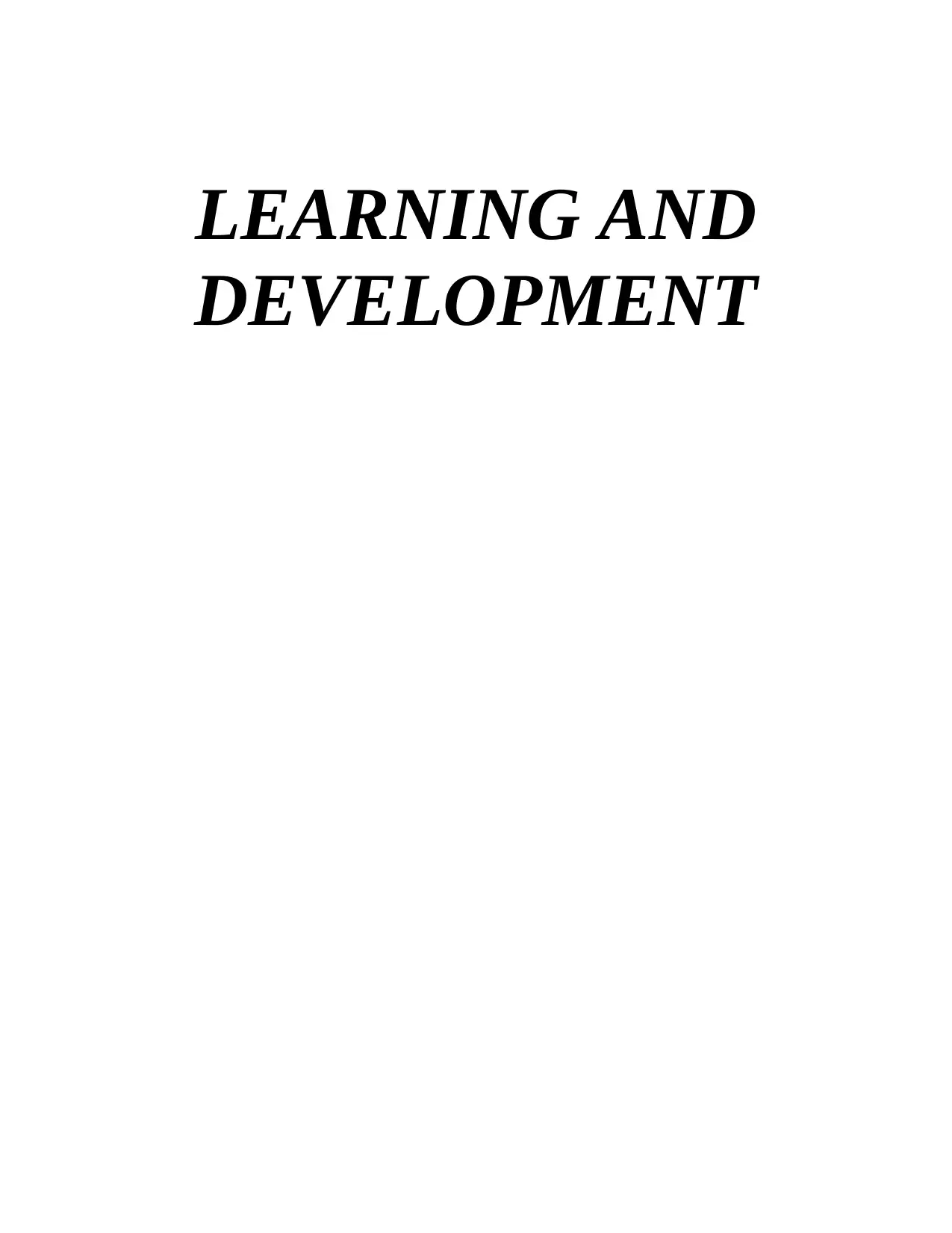
LEARNING AND
DEVELOPMENT
DEVELOPMENT
Paraphrase This Document
Need a fresh take? Get an instant paraphrase of this document with our AI Paraphraser
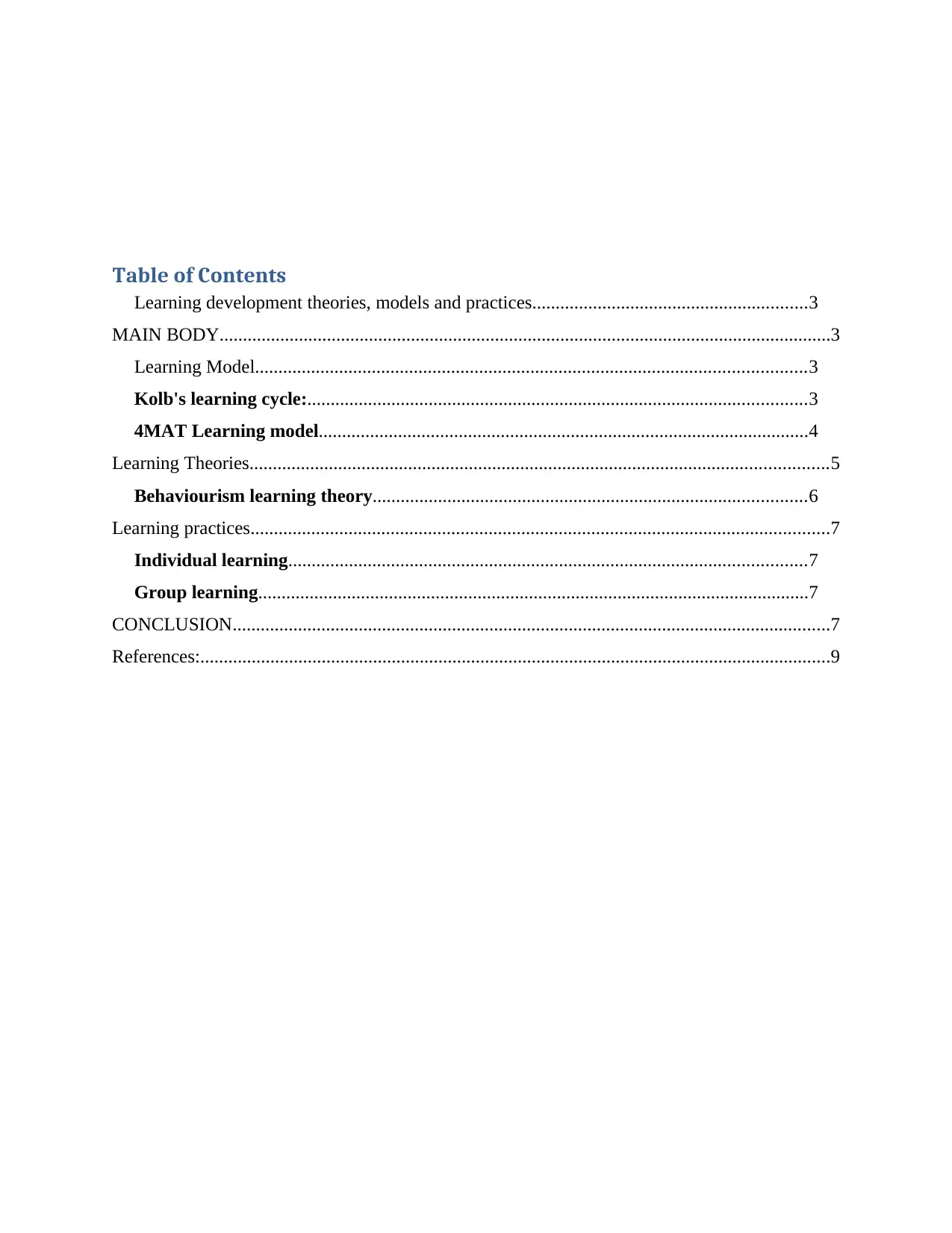
Table of Contents
Learning development theories, models and practices...........................................................3
MAIN BODY...................................................................................................................................3
Learning Model......................................................................................................................3
Kolb's learning cycle:...........................................................................................................3
4MAT Learning model.........................................................................................................4
Learning Theories............................................................................................................................5
Behaviourism learning theory.............................................................................................6
Learning practices............................................................................................................................7
Individual learning...............................................................................................................7
Group learning......................................................................................................................7
CONCLUSION................................................................................................................................7
References:.......................................................................................................................................9
Learning development theories, models and practices...........................................................3
MAIN BODY...................................................................................................................................3
Learning Model......................................................................................................................3
Kolb's learning cycle:...........................................................................................................3
4MAT Learning model.........................................................................................................4
Learning Theories............................................................................................................................5
Behaviourism learning theory.............................................................................................6
Learning practices............................................................................................................................7
Individual learning...............................................................................................................7
Group learning......................................................................................................................7
CONCLUSION................................................................................................................................7
References:.......................................................................................................................................9
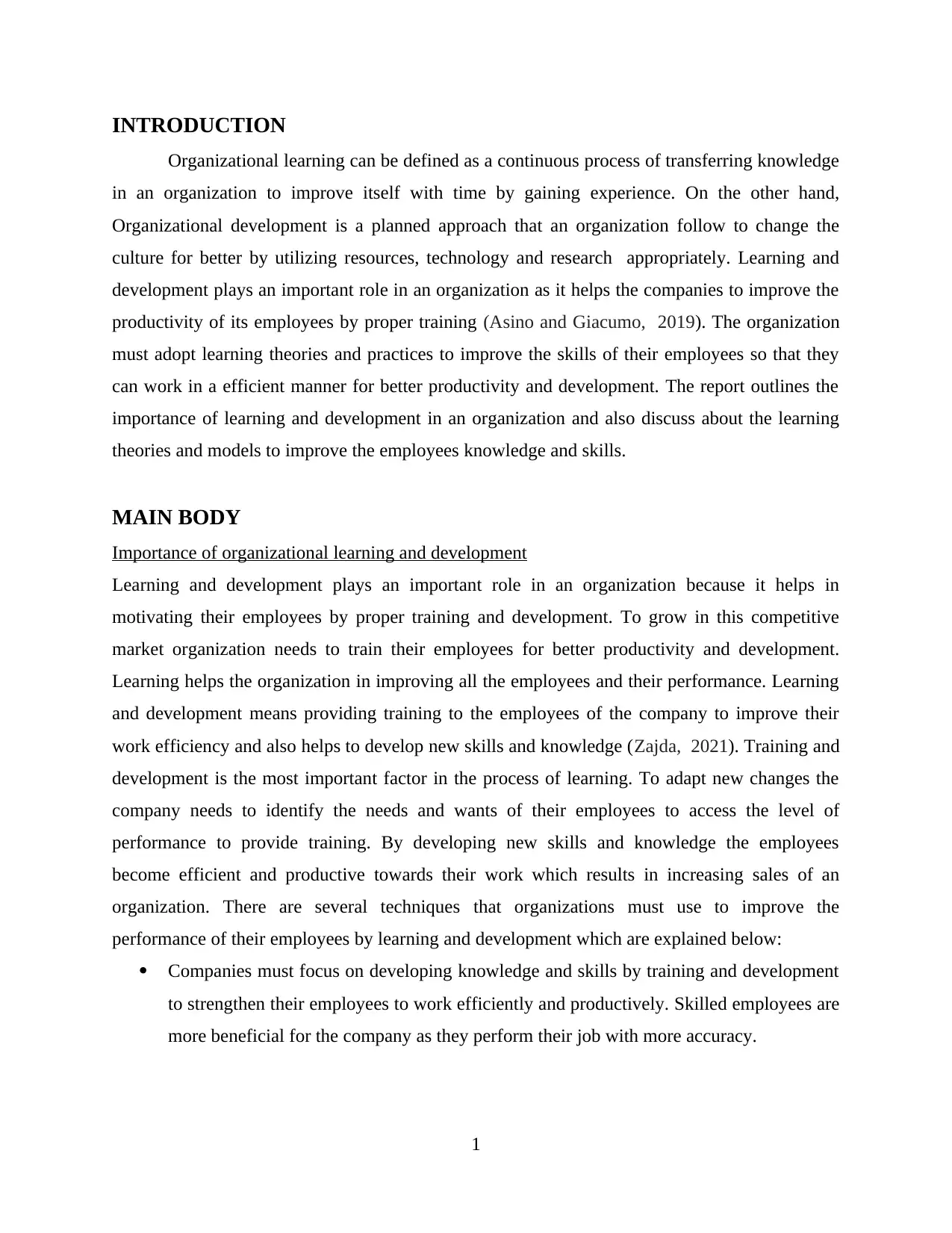
INTRODUCTION
Organizational learning can be defined as a continuous process of transferring knowledge
in an organization to improve itself with time by gaining experience. On the other hand,
Organizational development is a planned approach that an organization follow to change the
culture for better by utilizing resources, technology and research appropriately. Learning and
development plays an important role in an organization as it helps the companies to improve the
productivity of its employees by proper training (Asino and Giacumo, 2019). The organization
must adopt learning theories and practices to improve the skills of their employees so that they
can work in a efficient manner for better productivity and development. The report outlines the
importance of learning and development in an organization and also discuss about the learning
theories and models to improve the employees knowledge and skills.
MAIN BODY
Importance of organizational learning and development
Learning and development plays an important role in an organization because it helps in
motivating their employees by proper training and development. To grow in this competitive
market organization needs to train their employees for better productivity and development.
Learning helps the organization in improving all the employees and their performance. Learning
and development means providing training to the employees of the company to improve their
work efficiency and also helps to develop new skills and knowledge (Zajda, 2021). Training and
development is the most important factor in the process of learning. To adapt new changes the
company needs to identify the needs and wants of their employees to access the level of
performance to provide training. By developing new skills and knowledge the employees
become efficient and productive towards their work which results in increasing sales of an
organization. There are several techniques that organizations must use to improve the
performance of their employees by learning and development which are explained below:
Companies must focus on developing knowledge and skills by training and development
to strengthen their employees to work efficiently and productively. Skilled employees are
more beneficial for the company as they perform their job with more accuracy.
1
Organizational learning can be defined as a continuous process of transferring knowledge
in an organization to improve itself with time by gaining experience. On the other hand,
Organizational development is a planned approach that an organization follow to change the
culture for better by utilizing resources, technology and research appropriately. Learning and
development plays an important role in an organization as it helps the companies to improve the
productivity of its employees by proper training (Asino and Giacumo, 2019). The organization
must adopt learning theories and practices to improve the skills of their employees so that they
can work in a efficient manner for better productivity and development. The report outlines the
importance of learning and development in an organization and also discuss about the learning
theories and models to improve the employees knowledge and skills.
MAIN BODY
Importance of organizational learning and development
Learning and development plays an important role in an organization because it helps in
motivating their employees by proper training and development. To grow in this competitive
market organization needs to train their employees for better productivity and development.
Learning helps the organization in improving all the employees and their performance. Learning
and development means providing training to the employees of the company to improve their
work efficiency and also helps to develop new skills and knowledge (Zajda, 2021). Training and
development is the most important factor in the process of learning. To adapt new changes the
company needs to identify the needs and wants of their employees to access the level of
performance to provide training. By developing new skills and knowledge the employees
become efficient and productive towards their work which results in increasing sales of an
organization. There are several techniques that organizations must use to improve the
performance of their employees by learning and development which are explained below:
Companies must focus on developing knowledge and skills by training and development
to strengthen their employees to work efficiently and productively. Skilled employees are
more beneficial for the company as they perform their job with more accuracy.
1
⊘ This is a preview!⊘
Do you want full access?
Subscribe today to unlock all pages.

Trusted by 1+ million students worldwide
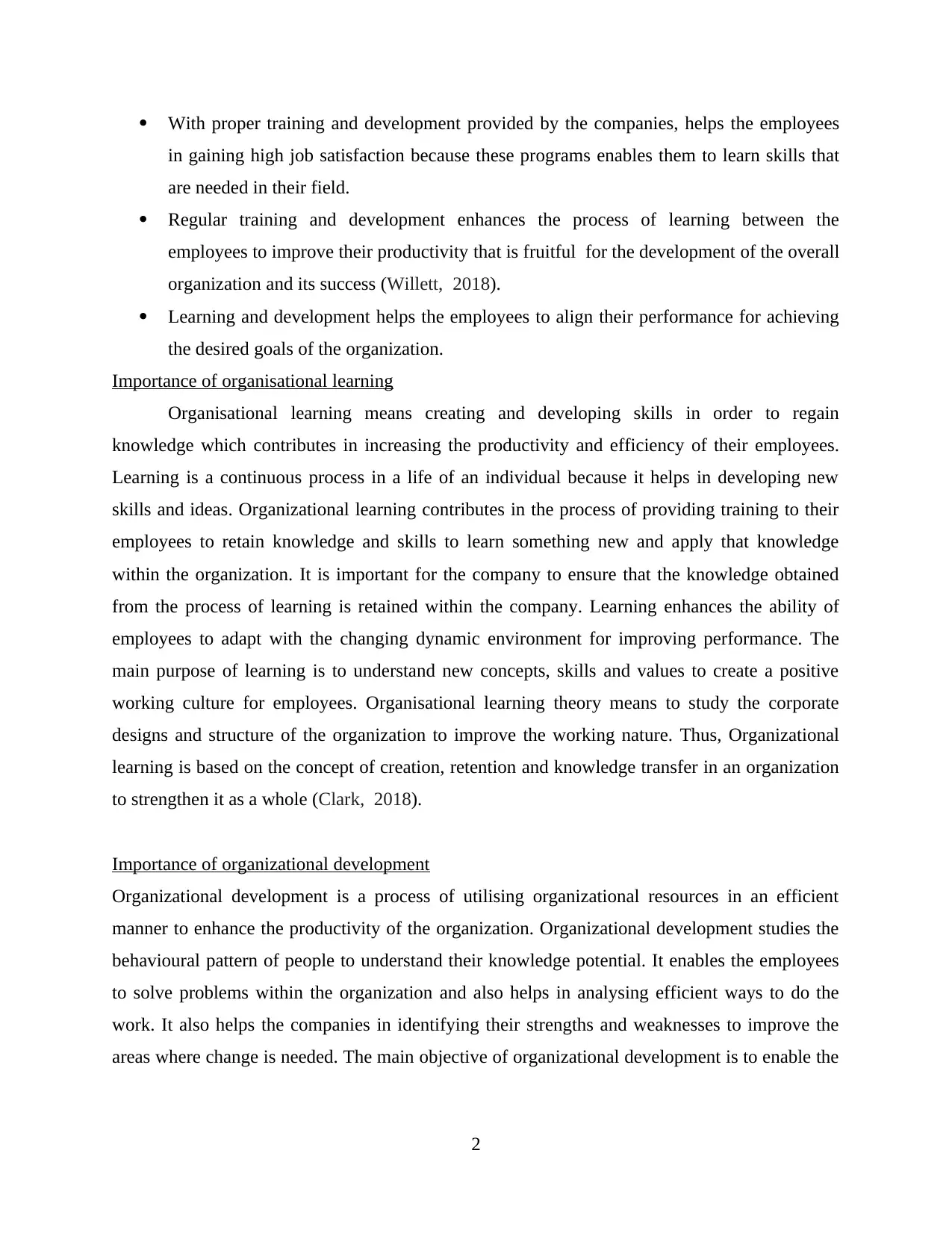
With proper training and development provided by the companies, helps the employees
in gaining high job satisfaction because these programs enables them to learn skills that
are needed in their field.
Regular training and development enhances the process of learning between the
employees to improve their productivity that is fruitful for the development of the overall
organization and its success (Willett, 2018).
Learning and development helps the employees to align their performance for achieving
the desired goals of the organization.
Importance of organisational learning
Organisational learning means creating and developing skills in order to regain
knowledge which contributes in increasing the productivity and efficiency of their employees.
Learning is a continuous process in a life of an individual because it helps in developing new
skills and ideas. Organizational learning contributes in the process of providing training to their
employees to retain knowledge and skills to learn something new and apply that knowledge
within the organization. It is important for the company to ensure that the knowledge obtained
from the process of learning is retained within the company. Learning enhances the ability of
employees to adapt with the changing dynamic environment for improving performance. The
main purpose of learning is to understand new concepts, skills and values to create a positive
working culture for employees. Organisational learning theory means to study the corporate
designs and structure of the organization to improve the working nature. Thus, Organizational
learning is based on the concept of creation, retention and knowledge transfer in an organization
to strengthen it as a whole (Clark, 2018).
Importance of organizational development
Organizational development is a process of utilising organizational resources in an efficient
manner to enhance the productivity of the organization. Organizational development studies the
behavioural pattern of people to understand their knowledge potential. It enables the employees
to solve problems within the organization and also helps in analysing efficient ways to do the
work. It also helps the companies in identifying their strengths and weaknesses to improve the
areas where change is needed. The main objective of organizational development is to enable the
2
in gaining high job satisfaction because these programs enables them to learn skills that
are needed in their field.
Regular training and development enhances the process of learning between the
employees to improve their productivity that is fruitful for the development of the overall
organization and its success (Willett, 2018).
Learning and development helps the employees to align their performance for achieving
the desired goals of the organization.
Importance of organisational learning
Organisational learning means creating and developing skills in order to regain
knowledge which contributes in increasing the productivity and efficiency of their employees.
Learning is a continuous process in a life of an individual because it helps in developing new
skills and ideas. Organizational learning contributes in the process of providing training to their
employees to retain knowledge and skills to learn something new and apply that knowledge
within the organization. It is important for the company to ensure that the knowledge obtained
from the process of learning is retained within the company. Learning enhances the ability of
employees to adapt with the changing dynamic environment for improving performance. The
main purpose of learning is to understand new concepts, skills and values to create a positive
working culture for employees. Organisational learning theory means to study the corporate
designs and structure of the organization to improve the working nature. Thus, Organizational
learning is based on the concept of creation, retention and knowledge transfer in an organization
to strengthen it as a whole (Clark, 2018).
Importance of organizational development
Organizational development is a process of utilising organizational resources in an efficient
manner to enhance the productivity of the organization. Organizational development studies the
behavioural pattern of people to understand their knowledge potential. It enables the employees
to solve problems within the organization and also helps in analysing efficient ways to do the
work. It also helps the companies in identifying their strengths and weaknesses to improve the
areas where change is needed. The main objective of organizational development is to enable the
2
Paraphrase This Document
Need a fresh take? Get an instant paraphrase of this document with our AI Paraphraser
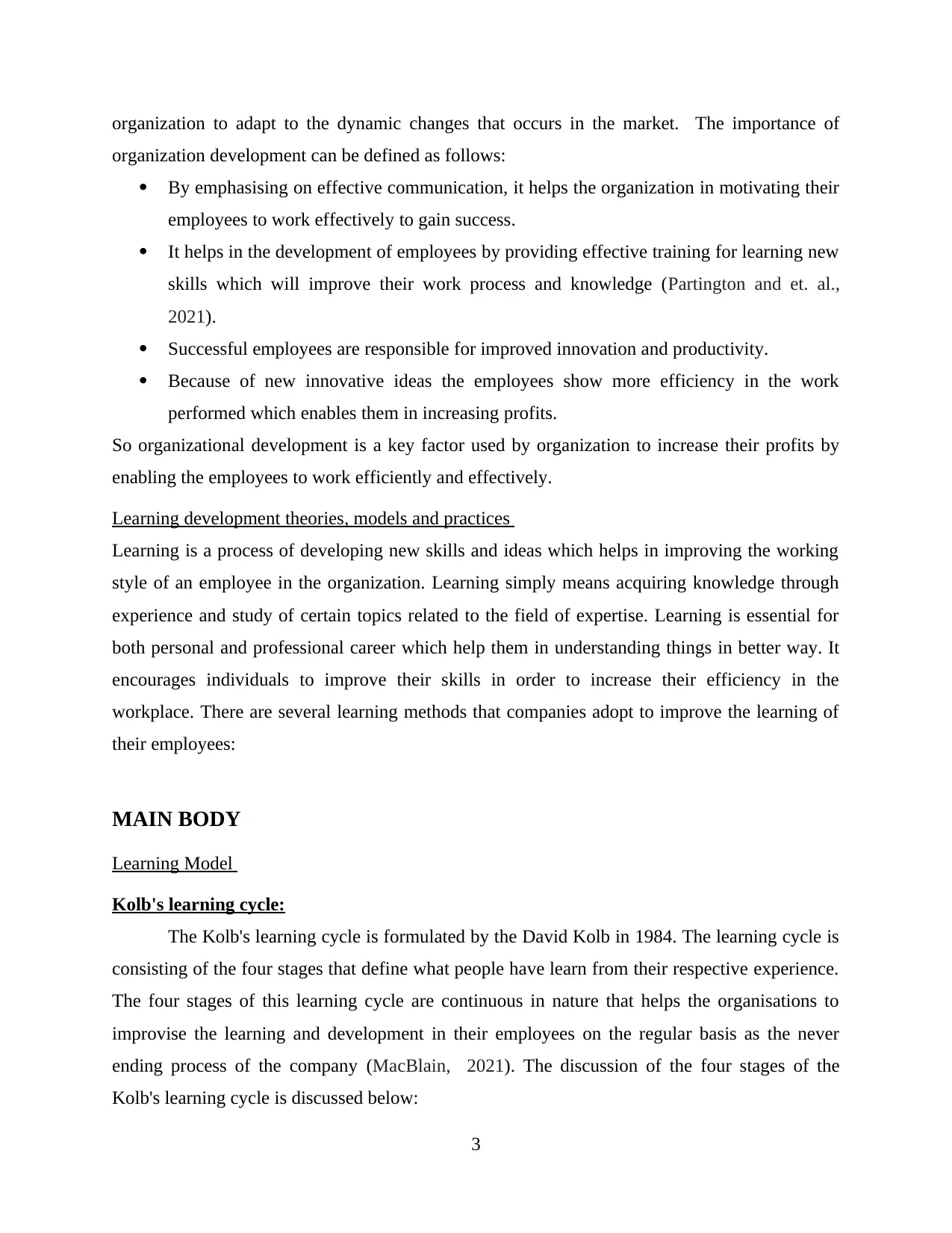
organization to adapt to the dynamic changes that occurs in the market. The importance of
organization development can be defined as follows:
By emphasising on effective communication, it helps the organization in motivating their
employees to work effectively to gain success.
It helps in the development of employees by providing effective training for learning new
skills which will improve their work process and knowledge (Partington and et. al.,
2021).
Successful employees are responsible for improved innovation and productivity.
Because of new innovative ideas the employees show more efficiency in the work
performed which enables them in increasing profits.
So organizational development is a key factor used by organization to increase their profits by
enabling the employees to work efficiently and effectively.
Learning development theories, models and practices
Learning is a process of developing new skills and ideas which helps in improving the working
style of an employee in the organization. Learning simply means acquiring knowledge through
experience and study of certain topics related to the field of expertise. Learning is essential for
both personal and professional career which help them in understanding things in better way. It
encourages individuals to improve their skills in order to increase their efficiency in the
workplace. There are several learning methods that companies adopt to improve the learning of
their employees:
MAIN BODY
Learning Model
Kolb's learning cycle:
The Kolb's learning cycle is formulated by the David Kolb in 1984. The learning cycle is
consisting of the four stages that define what people have learn from their respective experience.
The four stages of this learning cycle are continuous in nature that helps the organisations to
improvise the learning and development in their employees on the regular basis as the never
ending process of the company (MacBlain, 2021). The discussion of the four stages of the
Kolb's learning cycle is discussed below:
3
organization development can be defined as follows:
By emphasising on effective communication, it helps the organization in motivating their
employees to work effectively to gain success.
It helps in the development of employees by providing effective training for learning new
skills which will improve their work process and knowledge (Partington and et. al.,
2021).
Successful employees are responsible for improved innovation and productivity.
Because of new innovative ideas the employees show more efficiency in the work
performed which enables them in increasing profits.
So organizational development is a key factor used by organization to increase their profits by
enabling the employees to work efficiently and effectively.
Learning development theories, models and practices
Learning is a process of developing new skills and ideas which helps in improving the working
style of an employee in the organization. Learning simply means acquiring knowledge through
experience and study of certain topics related to the field of expertise. Learning is essential for
both personal and professional career which help them in understanding things in better way. It
encourages individuals to improve their skills in order to increase their efficiency in the
workplace. There are several learning methods that companies adopt to improve the learning of
their employees:
MAIN BODY
Learning Model
Kolb's learning cycle:
The Kolb's learning cycle is formulated by the David Kolb in 1984. The learning cycle is
consisting of the four stages that define what people have learn from their respective experience.
The four stages of this learning cycle are continuous in nature that helps the organisations to
improvise the learning and development in their employees on the regular basis as the never
ending process of the company (MacBlain, 2021). The discussion of the four stages of the
Kolb's learning cycle is discussed below:
3
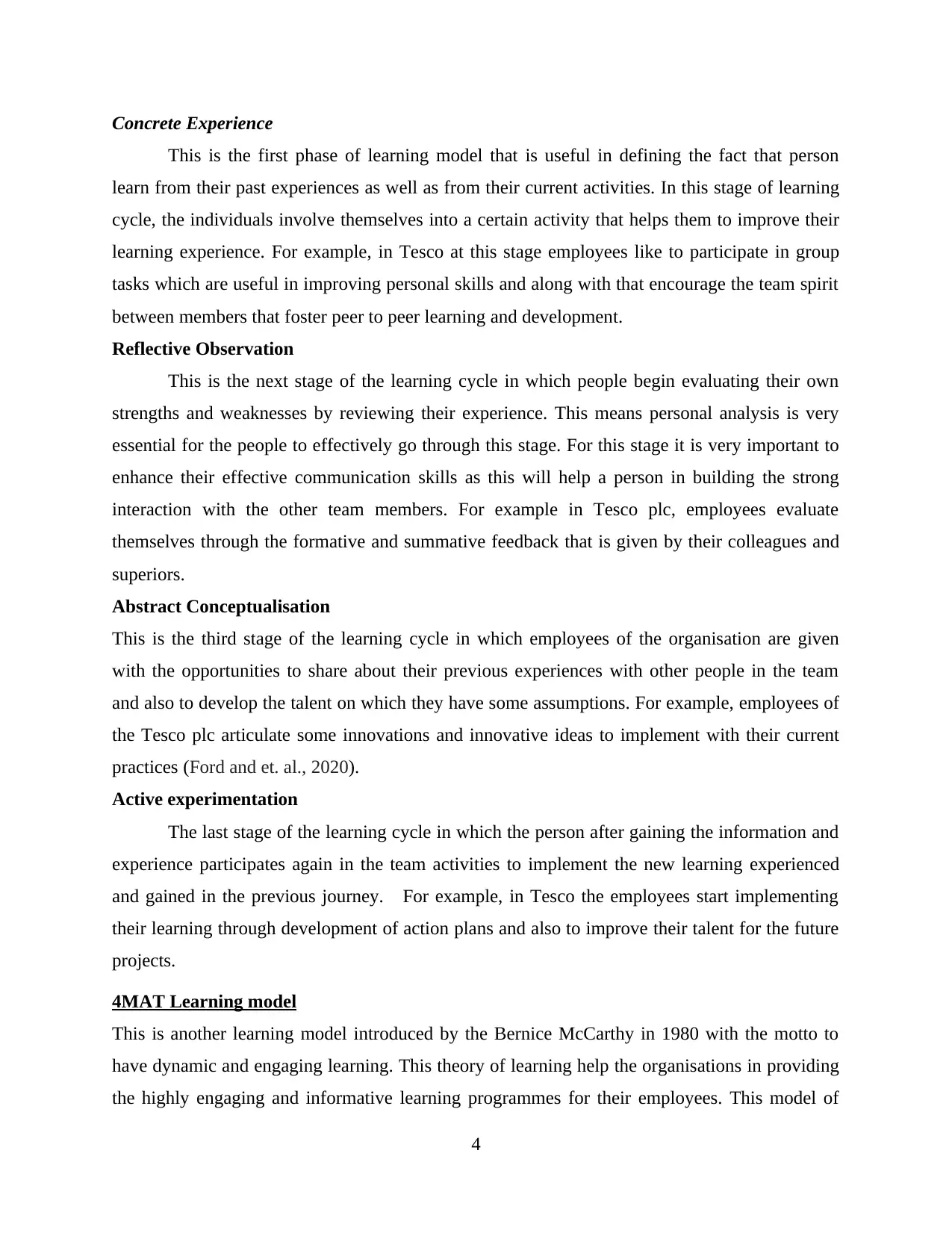
Concrete Experience
This is the first phase of learning model that is useful in defining the fact that person
learn from their past experiences as well as from their current activities. In this stage of learning
cycle, the individuals involve themselves into a certain activity that helps them to improve their
learning experience. For example, in Tesco at this stage employees like to participate in group
tasks which are useful in improving personal skills and along with that encourage the team spirit
between members that foster peer to peer learning and development.
Reflective Observation
This is the next stage of the learning cycle in which people begin evaluating their own
strengths and weaknesses by reviewing their experience. This means personal analysis is very
essential for the people to effectively go through this stage. For this stage it is very important to
enhance their effective communication skills as this will help a person in building the strong
interaction with the other team members. For example in Tesco plc, employees evaluate
themselves through the formative and summative feedback that is given by their colleagues and
superiors.
Abstract Conceptualisation
This is the third stage of the learning cycle in which employees of the organisation are given
with the opportunities to share about their previous experiences with other people in the team
and also to develop the talent on which they have some assumptions. For example, employees of
the Tesco plc articulate some innovations and innovative ideas to implement with their current
practices (Ford and et. al., 2020).
Active experimentation
The last stage of the learning cycle in which the person after gaining the information and
experience participates again in the team activities to implement the new learning experienced
and gained in the previous journey. For example, in Tesco the employees start implementing
their learning through development of action plans and also to improve their talent for the future
projects.
4MAT Learning model
This is another learning model introduced by the Bernice McCarthy in 1980 with the motto to
have dynamic and engaging learning. This theory of learning help the organisations in providing
the highly engaging and informative learning programmes for their employees. This model of
4
This is the first phase of learning model that is useful in defining the fact that person
learn from their past experiences as well as from their current activities. In this stage of learning
cycle, the individuals involve themselves into a certain activity that helps them to improve their
learning experience. For example, in Tesco at this stage employees like to participate in group
tasks which are useful in improving personal skills and along with that encourage the team spirit
between members that foster peer to peer learning and development.
Reflective Observation
This is the next stage of the learning cycle in which people begin evaluating their own
strengths and weaknesses by reviewing their experience. This means personal analysis is very
essential for the people to effectively go through this stage. For this stage it is very important to
enhance their effective communication skills as this will help a person in building the strong
interaction with the other team members. For example in Tesco plc, employees evaluate
themselves through the formative and summative feedback that is given by their colleagues and
superiors.
Abstract Conceptualisation
This is the third stage of the learning cycle in which employees of the organisation are given
with the opportunities to share about their previous experiences with other people in the team
and also to develop the talent on which they have some assumptions. For example, employees of
the Tesco plc articulate some innovations and innovative ideas to implement with their current
practices (Ford and et. al., 2020).
Active experimentation
The last stage of the learning cycle in which the person after gaining the information and
experience participates again in the team activities to implement the new learning experienced
and gained in the previous journey. For example, in Tesco the employees start implementing
their learning through development of action plans and also to improve their talent for the future
projects.
4MAT Learning model
This is another learning model introduced by the Bernice McCarthy in 1980 with the motto to
have dynamic and engaging learning. This theory of learning help the organisations in providing
the highly engaging and informative learning programmes for their employees. This model of
4
⊘ This is a preview!⊘
Do you want full access?
Subscribe today to unlock all pages.

Trusted by 1+ million students worldwide
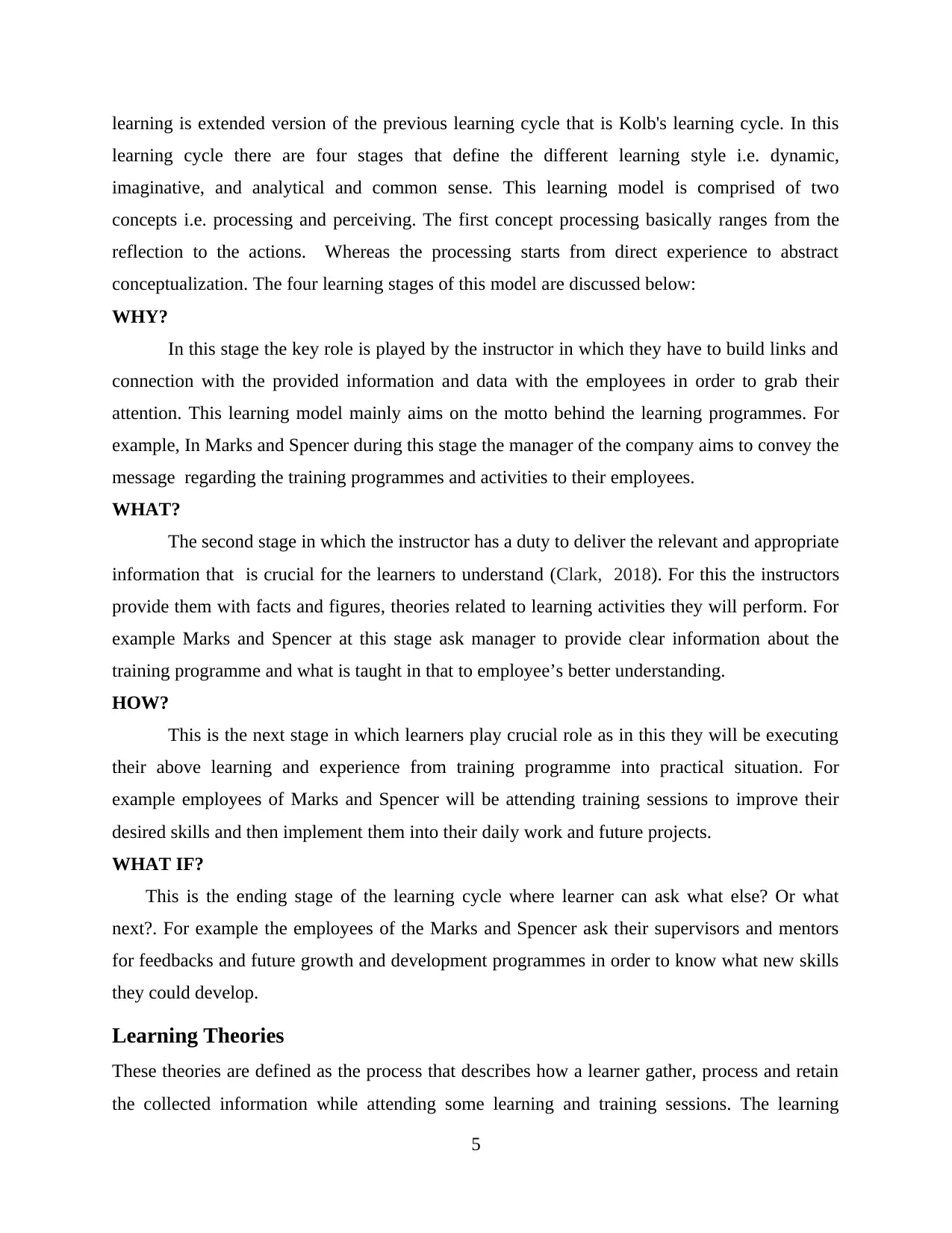
learning is extended version of the previous learning cycle that is Kolb's learning cycle. In this
learning cycle there are four stages that define the different learning style i.e. dynamic,
imaginative, and analytical and common sense. This learning model is comprised of two
concepts i.e. processing and perceiving. The first concept processing basically ranges from the
reflection to the actions. Whereas the processing starts from direct experience to abstract
conceptualization. The four learning stages of this model are discussed below:
WHY?
In this stage the key role is played by the instructor in which they have to build links and
connection with the provided information and data with the employees in order to grab their
attention. This learning model mainly aims on the motto behind the learning programmes. For
example, In Marks and Spencer during this stage the manager of the company aims to convey the
message regarding the training programmes and activities to their employees.
WHAT?
The second stage in which the instructor has a duty to deliver the relevant and appropriate
information that is crucial for the learners to understand (Clark, 2018). For this the instructors
provide them with facts and figures, theories related to learning activities they will perform. For
example Marks and Spencer at this stage ask manager to provide clear information about the
training programme and what is taught in that to employee’s better understanding.
HOW?
This is the next stage in which learners play crucial role as in this they will be executing
their above learning and experience from training programme into practical situation. For
example employees of Marks and Spencer will be attending training sessions to improve their
desired skills and then implement them into their daily work and future projects.
WHAT IF?
This is the ending stage of the learning cycle where learner can ask what else? Or what
next?. For example the employees of the Marks and Spencer ask their supervisors and mentors
for feedbacks and future growth and development programmes in order to know what new skills
they could develop.
Learning Theories
These theories are defined as the process that describes how a learner gather, process and retain
the collected information while attending some learning and training sessions. The learning
5
learning cycle there are four stages that define the different learning style i.e. dynamic,
imaginative, and analytical and common sense. This learning model is comprised of two
concepts i.e. processing and perceiving. The first concept processing basically ranges from the
reflection to the actions. Whereas the processing starts from direct experience to abstract
conceptualization. The four learning stages of this model are discussed below:
WHY?
In this stage the key role is played by the instructor in which they have to build links and
connection with the provided information and data with the employees in order to grab their
attention. This learning model mainly aims on the motto behind the learning programmes. For
example, In Marks and Spencer during this stage the manager of the company aims to convey the
message regarding the training programmes and activities to their employees.
WHAT?
The second stage in which the instructor has a duty to deliver the relevant and appropriate
information that is crucial for the learners to understand (Clark, 2018). For this the instructors
provide them with facts and figures, theories related to learning activities they will perform. For
example Marks and Spencer at this stage ask manager to provide clear information about the
training programme and what is taught in that to employee’s better understanding.
HOW?
This is the next stage in which learners play crucial role as in this they will be executing
their above learning and experience from training programme into practical situation. For
example employees of Marks and Spencer will be attending training sessions to improve their
desired skills and then implement them into their daily work and future projects.
WHAT IF?
This is the ending stage of the learning cycle where learner can ask what else? Or what
next?. For example the employees of the Marks and Spencer ask their supervisors and mentors
for feedbacks and future growth and development programmes in order to know what new skills
they could develop.
Learning Theories
These theories are defined as the process that describes how a learner gather, process and retain
the collected information while attending some learning and training sessions. The learning
5
Paraphrase This Document
Need a fresh take? Get an instant paraphrase of this document with our AI Paraphraser
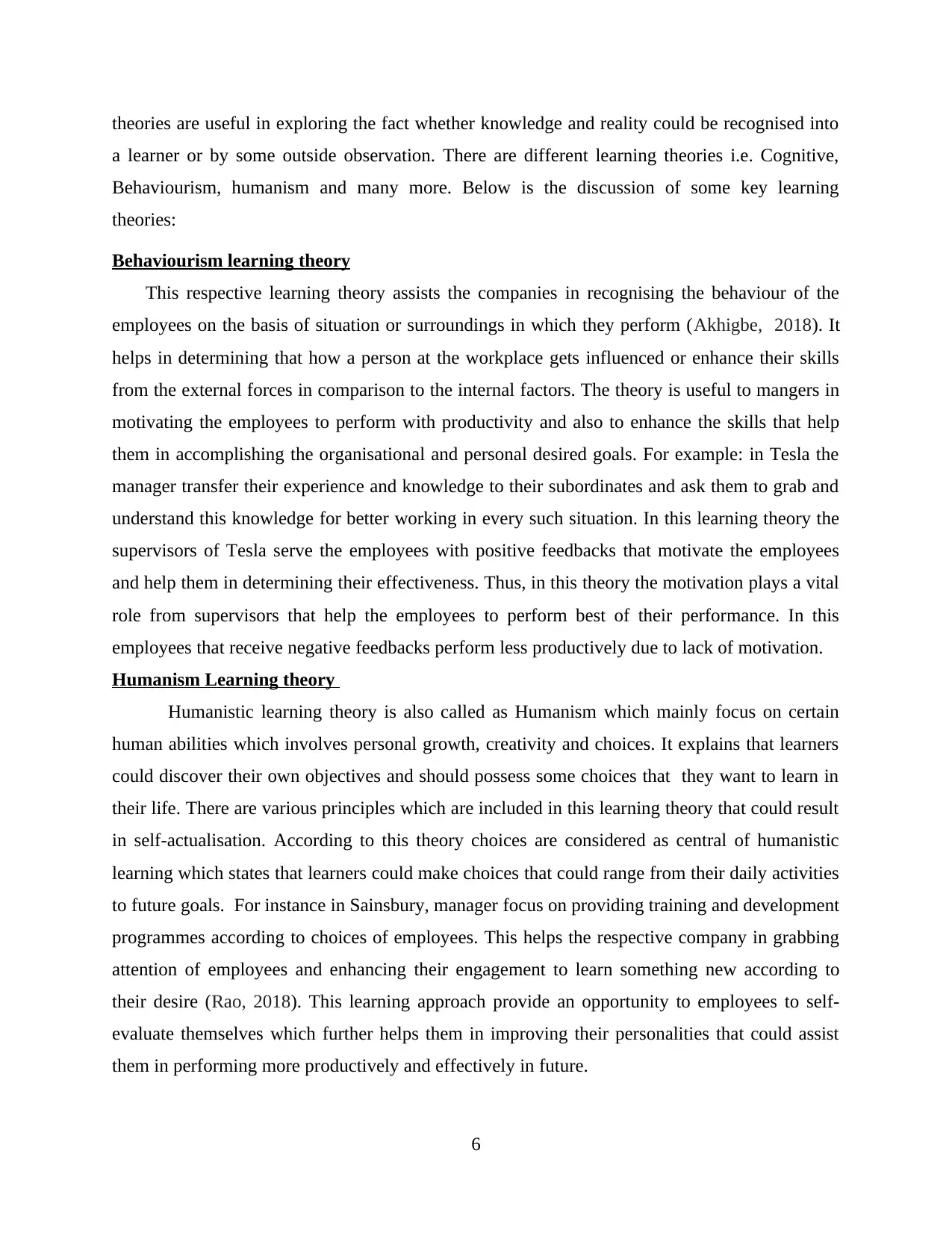
theories are useful in exploring the fact whether knowledge and reality could be recognised into
a learner or by some outside observation. There are different learning theories i.e. Cognitive,
Behaviourism, humanism and many more. Below is the discussion of some key learning
theories:
Behaviourism learning theory
This respective learning theory assists the companies in recognising the behaviour of the
employees on the basis of situation or surroundings in which they perform (Akhigbe, 2018). It
helps in determining that how a person at the workplace gets influenced or enhance their skills
from the external forces in comparison to the internal factors. The theory is useful to mangers in
motivating the employees to perform with productivity and also to enhance the skills that help
them in accomplishing the organisational and personal desired goals. For example: in Tesla the
manager transfer their experience and knowledge to their subordinates and ask them to grab and
understand this knowledge for better working in every such situation. In this learning theory the
supervisors of Tesla serve the employees with positive feedbacks that motivate the employees
and help them in determining their effectiveness. Thus, in this theory the motivation plays a vital
role from supervisors that help the employees to perform best of their performance. In this
employees that receive negative feedbacks perform less productively due to lack of motivation.
Humanism Learning theory
Humanistic learning theory is also called as Humanism which mainly focus on certain
human abilities which involves personal growth, creativity and choices. It explains that learners
could discover their own objectives and should possess some choices that they want to learn in
their life. There are various principles which are included in this learning theory that could result
in self-actualisation. According to this theory choices are considered as central of humanistic
learning which states that learners could make choices that could range from their daily activities
to future goals. For instance in Sainsbury, manager focus on providing training and development
programmes according to choices of employees. This helps the respective company in grabbing
attention of employees and enhancing their engagement to learn something new according to
their desire (Rao, 2018). This learning approach provide an opportunity to employees to self-
evaluate themselves which further helps them in improving their personalities that could assist
them in performing more productively and effectively in future.
6
a learner or by some outside observation. There are different learning theories i.e. Cognitive,
Behaviourism, humanism and many more. Below is the discussion of some key learning
theories:
Behaviourism learning theory
This respective learning theory assists the companies in recognising the behaviour of the
employees on the basis of situation or surroundings in which they perform (Akhigbe, 2018). It
helps in determining that how a person at the workplace gets influenced or enhance their skills
from the external forces in comparison to the internal factors. The theory is useful to mangers in
motivating the employees to perform with productivity and also to enhance the skills that help
them in accomplishing the organisational and personal desired goals. For example: in Tesla the
manager transfer their experience and knowledge to their subordinates and ask them to grab and
understand this knowledge for better working in every such situation. In this learning theory the
supervisors of Tesla serve the employees with positive feedbacks that motivate the employees
and help them in determining their effectiveness. Thus, in this theory the motivation plays a vital
role from supervisors that help the employees to perform best of their performance. In this
employees that receive negative feedbacks perform less productively due to lack of motivation.
Humanism Learning theory
Humanistic learning theory is also called as Humanism which mainly focus on certain
human abilities which involves personal growth, creativity and choices. It explains that learners
could discover their own objectives and should possess some choices that they want to learn in
their life. There are various principles which are included in this learning theory that could result
in self-actualisation. According to this theory choices are considered as central of humanistic
learning which states that learners could make choices that could range from their daily activities
to future goals. For instance in Sainsbury, manager focus on providing training and development
programmes according to choices of employees. This helps the respective company in grabbing
attention of employees and enhancing their engagement to learn something new according to
their desire (Rao, 2018). This learning approach provide an opportunity to employees to self-
evaluate themselves which further helps them in improving their personalities that could assist
them in performing more productively and effectively in future.
6
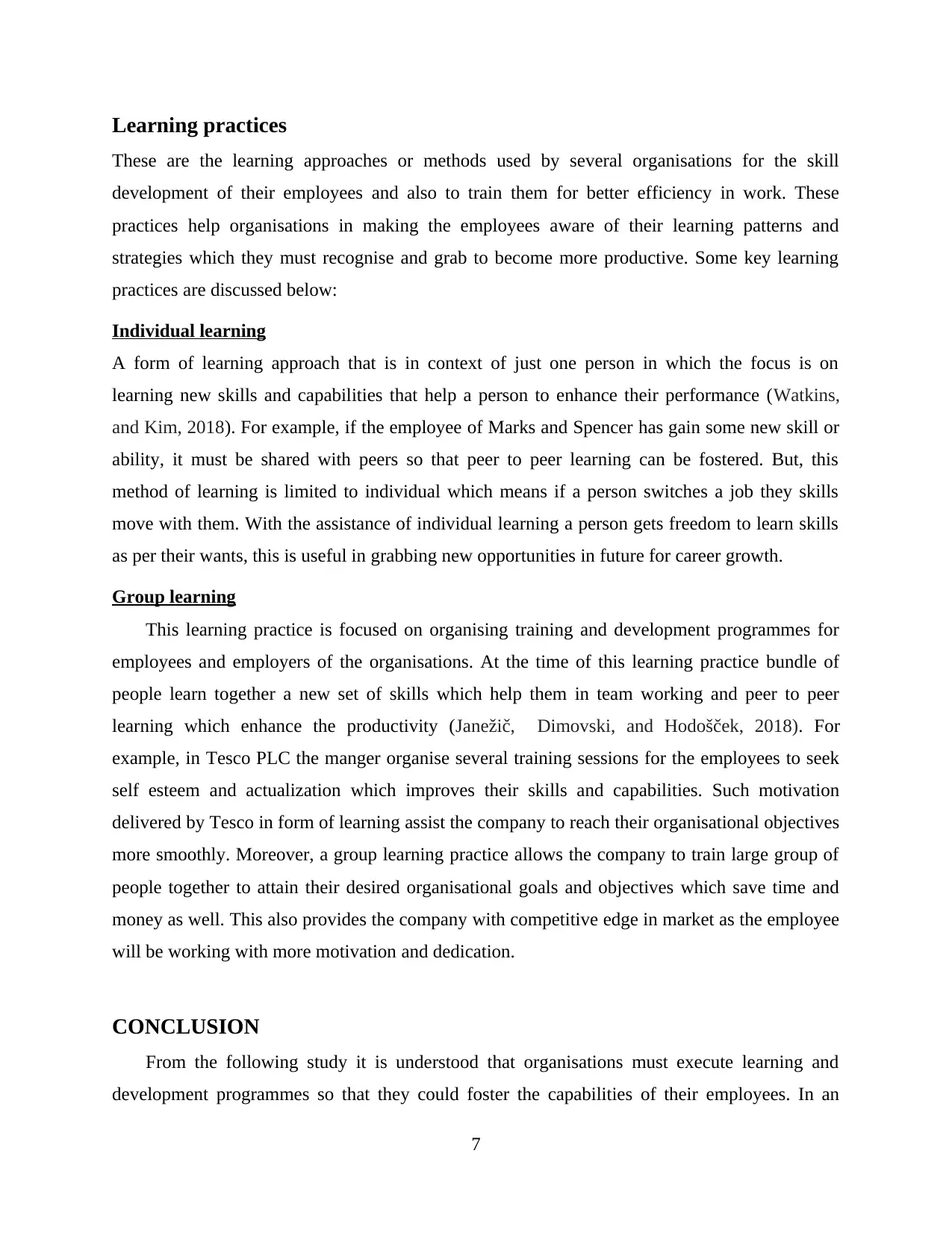
Learning practices
These are the learning approaches or methods used by several organisations for the skill
development of their employees and also to train them for better efficiency in work. These
practices help organisations in making the employees aware of their learning patterns and
strategies which they must recognise and grab to become more productive. Some key learning
practices are discussed below:
Individual learning
A form of learning approach that is in context of just one person in which the focus is on
learning new skills and capabilities that help a person to enhance their performance (Watkins,
and Kim, 2018). For example, if the employee of Marks and Spencer has gain some new skill or
ability, it must be shared with peers so that peer to peer learning can be fostered. But, this
method of learning is limited to individual which means if a person switches a job they skills
move with them. With the assistance of individual learning a person gets freedom to learn skills
as per their wants, this is useful in grabbing new opportunities in future for career growth.
Group learning
This learning practice is focused on organising training and development programmes for
employees and employers of the organisations. At the time of this learning practice bundle of
people learn together a new set of skills which help them in team working and peer to peer
learning which enhance the productivity (Janežič, Dimovski, and Hodošček, 2018). For
example, in Tesco PLC the manger organise several training sessions for the employees to seek
self esteem and actualization which improves their skills and capabilities. Such motivation
delivered by Tesco in form of learning assist the company to reach their organisational objectives
more smoothly. Moreover, a group learning practice allows the company to train large group of
people together to attain their desired organisational goals and objectives which save time and
money as well. This also provides the company with competitive edge in market as the employee
will be working with more motivation and dedication.
CONCLUSION
From the following study it is understood that organisations must execute learning and
development programmes so that they could foster the capabilities of their employees. In an
7
These are the learning approaches or methods used by several organisations for the skill
development of their employees and also to train them for better efficiency in work. These
practices help organisations in making the employees aware of their learning patterns and
strategies which they must recognise and grab to become more productive. Some key learning
practices are discussed below:
Individual learning
A form of learning approach that is in context of just one person in which the focus is on
learning new skills and capabilities that help a person to enhance their performance (Watkins,
and Kim, 2018). For example, if the employee of Marks and Spencer has gain some new skill or
ability, it must be shared with peers so that peer to peer learning can be fostered. But, this
method of learning is limited to individual which means if a person switches a job they skills
move with them. With the assistance of individual learning a person gets freedom to learn skills
as per their wants, this is useful in grabbing new opportunities in future for career growth.
Group learning
This learning practice is focused on organising training and development programmes for
employees and employers of the organisations. At the time of this learning practice bundle of
people learn together a new set of skills which help them in team working and peer to peer
learning which enhance the productivity (Janežič, Dimovski, and Hodošček, 2018). For
example, in Tesco PLC the manger organise several training sessions for the employees to seek
self esteem and actualization which improves their skills and capabilities. Such motivation
delivered by Tesco in form of learning assist the company to reach their organisational objectives
more smoothly. Moreover, a group learning practice allows the company to train large group of
people together to attain their desired organisational goals and objectives which save time and
money as well. This also provides the company with competitive edge in market as the employee
will be working with more motivation and dedication.
CONCLUSION
From the following study it is understood that organisations must execute learning and
development programmes so that they could foster the capabilities of their employees. In an
7
⊘ This is a preview!⊘
Do you want full access?
Subscribe today to unlock all pages.

Trusted by 1+ million students worldwide
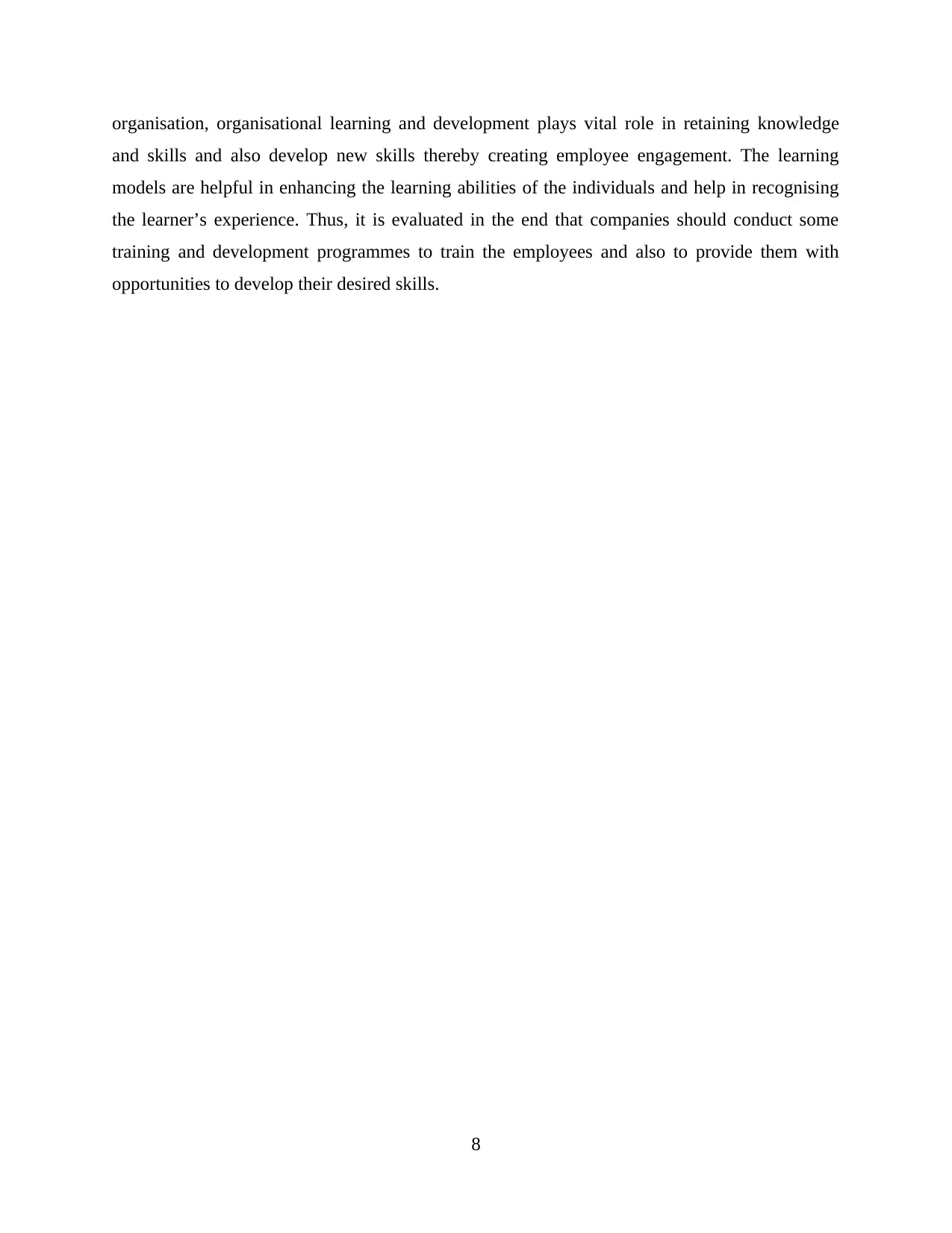
organisation, organisational learning and development plays vital role in retaining knowledge
and skills and also develop new skills thereby creating employee engagement. The learning
models are helpful in enhancing the learning abilities of the individuals and help in recognising
the learner’s experience. Thus, it is evaluated in the end that companies should conduct some
training and development programmes to train the employees and also to provide them with
opportunities to develop their desired skills.
8
and skills and also develop new skills thereby creating employee engagement. The learning
models are helpful in enhancing the learning abilities of the individuals and help in recognising
the learner’s experience. Thus, it is evaluated in the end that companies should conduct some
training and development programmes to train the employees and also to provide them with
opportunities to develop their desired skills.
8
Paraphrase This Document
Need a fresh take? Get an instant paraphrase of this document with our AI Paraphraser
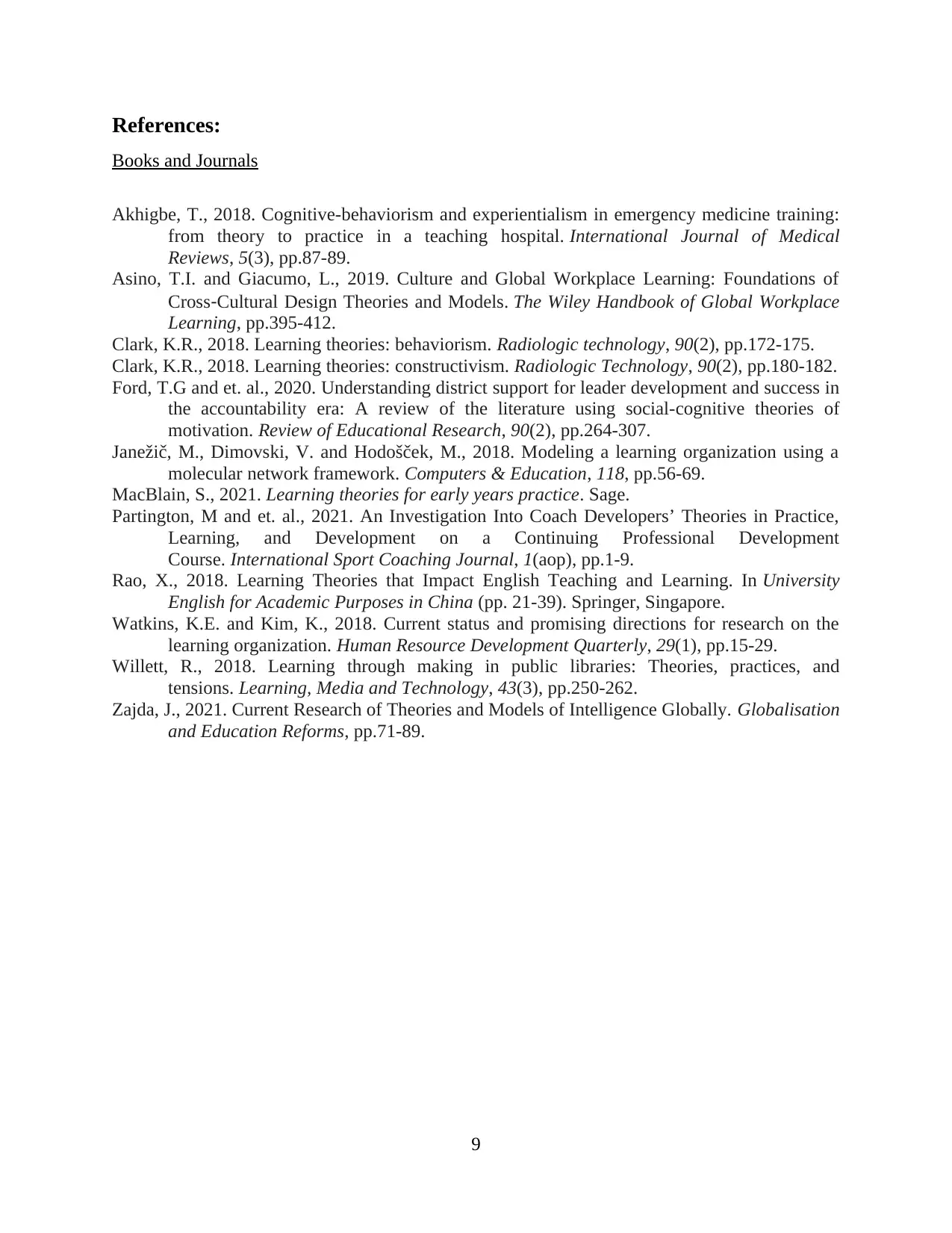
References:
Books and Journals
Akhigbe, T., 2018. Cognitive-behaviorism and experientialism in emergency medicine training:
from theory to practice in a teaching hospital. International Journal of Medical
Reviews, 5(3), pp.87-89.
Asino, T.I. and Giacumo, L., 2019. Culture and Global Workplace Learning: Foundations of
Cross‐Cultural Design Theories and Models. The Wiley Handbook of Global Workplace
Learning, pp.395-412.
Clark, K.R., 2018. Learning theories: behaviorism. Radiologic technology, 90(2), pp.172-175.
Clark, K.R., 2018. Learning theories: constructivism. Radiologic Technology, 90(2), pp.180-182.
Ford, T.G and et. al., 2020. Understanding district support for leader development and success in
the accountability era: A review of the literature using social-cognitive theories of
motivation. Review of Educational Research, 90(2), pp.264-307.
Janežič, M., Dimovski, V. and Hodošček, M., 2018. Modeling a learning organization using a
molecular network framework. Computers & Education, 118, pp.56-69.
MacBlain, S., 2021. Learning theories for early years practice. Sage.
Partington, M and et. al., 2021. An Investigation Into Coach Developers’ Theories in Practice,
Learning, and Development on a Continuing Professional Development
Course. International Sport Coaching Journal, 1(aop), pp.1-9.
Rao, X., 2018. Learning Theories that Impact English Teaching and Learning. In University
English for Academic Purposes in China (pp. 21-39). Springer, Singapore.
Watkins, K.E. and Kim, K., 2018. Current status and promising directions for research on the
learning organization. Human Resource Development Quarterly, 29(1), pp.15-29.
Willett, R., 2018. Learning through making in public libraries: Theories, practices, and
tensions. Learning, Media and Technology, 43(3), pp.250-262.
Zajda, J., 2021. Current Research of Theories and Models of Intelligence Globally. Globalisation
and Education Reforms, pp.71-89.
9
Books and Journals
Akhigbe, T., 2018. Cognitive-behaviorism and experientialism in emergency medicine training:
from theory to practice in a teaching hospital. International Journal of Medical
Reviews, 5(3), pp.87-89.
Asino, T.I. and Giacumo, L., 2019. Culture and Global Workplace Learning: Foundations of
Cross‐Cultural Design Theories and Models. The Wiley Handbook of Global Workplace
Learning, pp.395-412.
Clark, K.R., 2018. Learning theories: behaviorism. Radiologic technology, 90(2), pp.172-175.
Clark, K.R., 2018. Learning theories: constructivism. Radiologic Technology, 90(2), pp.180-182.
Ford, T.G and et. al., 2020. Understanding district support for leader development and success in
the accountability era: A review of the literature using social-cognitive theories of
motivation. Review of Educational Research, 90(2), pp.264-307.
Janežič, M., Dimovski, V. and Hodošček, M., 2018. Modeling a learning organization using a
molecular network framework. Computers & Education, 118, pp.56-69.
MacBlain, S., 2021. Learning theories for early years practice. Sage.
Partington, M and et. al., 2021. An Investigation Into Coach Developers’ Theories in Practice,
Learning, and Development on a Continuing Professional Development
Course. International Sport Coaching Journal, 1(aop), pp.1-9.
Rao, X., 2018. Learning Theories that Impact English Teaching and Learning. In University
English for Academic Purposes in China (pp. 21-39). Springer, Singapore.
Watkins, K.E. and Kim, K., 2018. Current status and promising directions for research on the
learning organization. Human Resource Development Quarterly, 29(1), pp.15-29.
Willett, R., 2018. Learning through making in public libraries: Theories, practices, and
tensions. Learning, Media and Technology, 43(3), pp.250-262.
Zajda, J., 2021. Current Research of Theories and Models of Intelligence Globally. Globalisation
and Education Reforms, pp.71-89.
9
1 out of 11
Related Documents
Your All-in-One AI-Powered Toolkit for Academic Success.
+13062052269
info@desklib.com
Available 24*7 on WhatsApp / Email
![[object Object]](/_next/static/media/star-bottom.7253800d.svg)
Unlock your academic potential
Copyright © 2020–2025 A2Z Services. All Rights Reserved. Developed and managed by ZUCOL.





